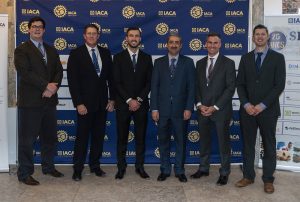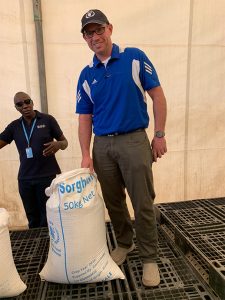
Swipe For More >
Checkoff Newsletter – Winter 2020
Herbicide Trait Technologies On the Horizon
by Brent Bean, Ph.D.
For years sorghum growers have expressed a need for an effective postemergence grass control option. Soon, farmers will be able to choose between three herbicide tolerant traits in grain sorghum that directly address this need. These traits have been integrated into elite sorghum germplasm through standard crop breeding techniques, and three up-and-coming technologies are expected to be commercially available for either the 2021 or 2022 growing seasons.
The three technologies are being developed by different seed companies, each using a different herbicide trait. Hybrids with ACCase, sulfonylurea or imidazolinone tolerance are now in the pipeline to aid in sorghum weed control.
Fortunately, the industry has learned from other crops on how to best use and prolong the life of herbicide tolerant trait technologies. The Sorghum Checkoff will work with seed and crop protection companies to ensure sufficient information and guidelines are provided on how to avoid the occurrence of weed resistance when these technologies enter the market. Although the specific set of guidelines and educational materials provided may vary slightly with each technology, many similarities will exist for best management practices.
The goal is to use these technologies responsibly to ensure their effectiveness and viability for many years. Having three herbicide technologies available for use should help minimize resistance to any one particular technology and is a very positive step for U.S. sorghum producers.
Sorghum Farmers Graduate from Leadership Sorghum Class IV
by Samantha Barnett
 On Dec. 11, in conjunction with the Sorghum Checkoff annual winter board meeting Leadership Sorghum Class IV graduated from the 15-month program. The 14-member class participated in five different sessions, each showcasing different aspects of the multifaceted sorghum industry.
On Dec. 11, in conjunction with the Sorghum Checkoff annual winter board meeting Leadership Sorghum Class IV graduated from the 15-month program. The 14-member class participated in five different sessions, each showcasing different aspects of the multifaceted sorghum industry.
The Sorghum Checkoff recognized each member with a certificate of completion and photobook presented by Sorghum Checkoff Chairwoman Verity Ulibarri to commemorate their time in the Leadership Sorghum program. The 14 graduates are Auden Aranda of Keyes, Oklahoma; John Bergkamp of Garden Plains, Kansas; Jon Berning of Scott City, Kansas; Dustin Borden of Gruver, Texas; Michael Brooks from Walsh, Colorado; Matthew Davis from Manhattan, Kansas; Jaden DeVore of Cheney, Kansas; Jace Gibbs of Dighton, Kansas; David Junker of McCook, Nebraska; Larry Kendig of Osborne, Kansas; Kevin Pshigoda of Perryton, Texas; Cole Rohr of Quinter, Kansas; Tony Watson of Healy, Kansas; and Matthew Winter of Canyon, Texas.
“We would like to congratulate each graduate of Leadership Sorghum Class IV,” Sorghum Checkoff Executive Director Floretino Lopez said. “It is our sincere hope that each graduate leaves this program equipped with the skills and knowledge to make a meaningful difference in agriculture, the sorghum industry, on their operations and in their communities.”
U.S. Sorghum Meets International Demand in Europe, Africa and Asia Through Global Expeditions
by Samantha Barnett
Spain, Portugal Expedition
 Sorghum Checkoff Secretary Jim Massey participated in a six-member, week-long mission to Spain and Portugal to promote U.S. sorghum and DDGS to international markets in conjunction with the U.S. Grains Council.
Sorghum Checkoff Secretary Jim Massey participated in a six-member, week-long mission to Spain and Portugal to promote U.S. sorghum and DDGS to international markets in conjunction with the U.S. Grains Council.
The delegation consisting of a variety of industry representatives and USGC staff visited various Spanish and Portuguese industry sectors to both promote U.S. sorghum and discover the demand from different markets. A culmination of market availability and biosecurity make U.S. sorghum an attractive alternative to other feedstocks and biofuels, like corn.
“We wanted to have someone on the trip to represent sorghum, talk about U.S. farmers and the difference between sourcing sorghum through the U.S. versus other countries,” Massey said. “Because U.S. sorghum is non-GMO, versatile and sustainable, it fits into several international marketplaces.”
The team’s primary focus was interacting with the Spanish and Portuguese feed industries. In Spain, they attended various meetings and conferences to discuss potential exports into the Spanish market. In Portugal, the team attended the 50th annual gala dinner for the Portuguese animal feed association to network and promote U.S. grain among the event’s 200 guests. Overall, the expedition proved that European buyers are interested in U.S. sorghum eager to take advantage of market opportunities.
Japan Expedition
Sorghum Checkoff Board Director Shayne Suppes will be traveling to Japan Jan. 18 through Jan. 24, 2020, promoting U.S. sorghum to the emerging Japanese market. Suppes’s main goal for the trip is to reconnect with Asain buyers he met during Export Sorghum, an exclusive, one-day educational seminar for grain buyers from around the world, while promoting American grain with particular focus on food-grade varieties.
“I think the Japanese market may be the hidden gem U.S. sorghum farmers have been looking for,” Suppes said. “The potential for market expansion in Japan is great because they’re interested in both specialty and bulk sorghum varieties.”
East Africa Expedition
 Sorghum Checkoff Board Director Adam Schindler from Reliance, South Dakota, recently traveled to eastern Africa on a food aid mission with the U.S. Grains Council. The Council is leveraging its market development work in Tanzania to create new opportunities for U.S. sorghum exports. The primary purpose of the trip was to identify the needs of east Africans in terms of food aid and to understand how U.S. sorghum could penetrate the market combating food insecurity.
Sorghum Checkoff Board Director Adam Schindler from Reliance, South Dakota, recently traveled to eastern Africa on a food aid mission with the U.S. Grains Council. The Council is leveraging its market development work in Tanzania to create new opportunities for U.S. sorghum exports. The primary purpose of the trip was to identify the needs of east Africans in terms of food aid and to understand how U.S. sorghum could penetrate the market combating food insecurity.
“The market opportunities available in eastern Africa, Kenya especially, are virtually untapped,” Schindler said. “U.S. sorghum has the ability to feed about 190,000 refugees in Kenya, and we see opportunity to invest in that market.”
The mission demonstrates both the USCP and USGC’s desire to provide U.S. sorghum to food insecure or vulnerable countries. Schindler said he is grateful to be a sorghum farmer helping combat malnutrition through his crop. Through programs facilitated by organizations combating food insecurity, like U.S. International Development Agency and UN World Food Programme, U.S. sorghum farmers have the ability to produce grain to help feed thousands of East African citizens and Kenyan refugees.
“We are producing high quality grain to feed not only our nation but the world,” Schindler said.
Industry-Wide Collaboration
These expeditions were made possible by funding from the United States Department of Agriculture Agricultural Trade Promotion Program. The ATP program aims to help U.S. agricultural exports develop new markets and mitigate the effects of tariffs. The U.S. Grains Council was allocated $20.8 million dollars this year by the program and is collaborating with USCP to encourage market growth and exploration for U.S. sorghum.
###
These stories originally appeared in the Winter 2020 Issue of Sorghum Grower magazine as a paid advertisement in the form of the Sorghum Checkoff Newsletter.


